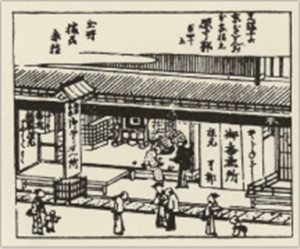Kitsune udon on a cold morning
Yoshie Doi

Kitsune udon made on January 14, 2024 |
 Hararyokaku store that is published in“2000 Sodekagami” on the 1847 edition |
Ever since I was a child, I have wondered why kitsune udon topped with fried tofu is called kitsune udon. If you go to Tokyo, you’ll find Tanuki Udon, which is udon topped with tempura, and I was surprised when it was served in pitch-black soup with Tempura bits on top. In Tokyo, the filling of tempura and removing the seeds seems to have changed to tanuki. In Kyoto, tanuki udon is kitsune udon with ankake sauce. Tanuki soba means fox soba.
Kitsune udon has its roots in a long-established udon restaurant in Osaka. Abura-Age was served as a side dish and kamaboko was served separately, but it seems that it started when customers put Abura-Age on top of udon noodles and ate it. The reason why it’s a Abura-Age is because the owner of the restaurant trained at a sushi restaurant, where Inari used to make Inari sushi.
At first it was called “Konkon-san,” but since the fox is a symbol of business prosperity, it seems to have changed to “Kitsune Udon.” I boil Abura-age until sweet and spicy, freeze it, and prepare kitsune udon whenever I want. I prepare the dashi stock so that I can use it up within 3 days and enjoy it often during the cold winter months. It warms your body.
In the Edo period, if you caught a cold, you would eat warm udon noodles at an udon restaurant and take Chinese herbal medicine to cure yourself. Chinese herbal medicines were sold at udon restaurants. It seems that black shichimi was originally used as a medicine. The gokosen that was prescribed under the guidance of Dr. Yamawaki, a Chinese herbalist, was passed down from generation to generation, and is still sold in Gion today. I’ve been eating kitsune udon at Kuro Shichimi for many years, and I love Kyoto’s kitsune udon.It’s compact, so I bring it with me as a souvenir.
The end of document
Translated by Masami Otani
